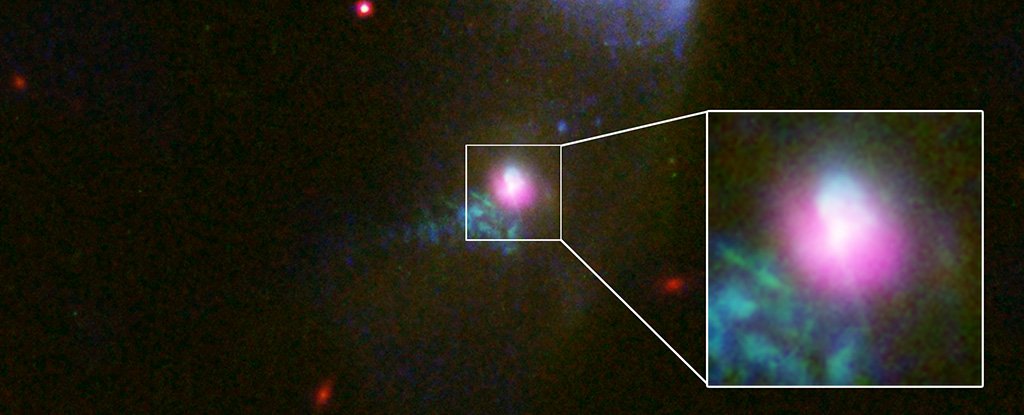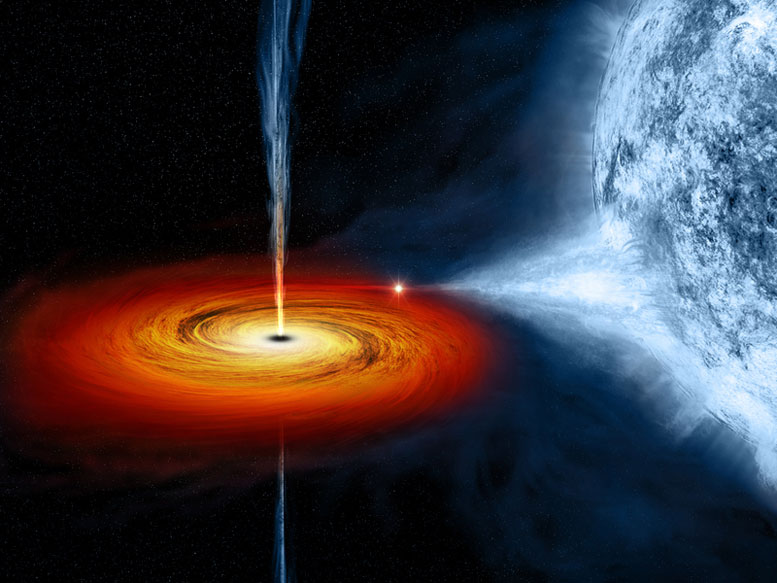Black holes don't just sit
there munching away constantly on the space around them. Eventually they run
out of nearby matter and go quiet, laying in wait until a stray bit of gas
passes by. Then a black hole devours again, belching out a giant jet of
particles. And now scientists have captured one doing so not once, but twice -
the first time this has been observed.
The two burps, occurring
within the span of 100,000 years, confirm that supermassive black holes go
through cycles of hibernation and activity. It's actually not as animalistic as
all that, since black holes aren't living or sentient, but it's a decent-enough
metaphor for the way black holes devour material, drawing it in with their
tremendous gravity.
But even though we're used
to think how nothing ever comes back out of a black hole, the curious thing is
that they don't retain everything they capture. When they consume matter such
as gas or stars, they also generate a powerful outflow of high-energy particles
from close to the event horizon, but not beyond the point of no return.
"Black holes are
voracious eaters, but it also turns out they don't have very good table
manners," said lead researcher Julie Comerford, an astronomer at the
University of Colorado Boulder.
"We know a lot of
examples of black holes with single burps emanating out, but we discovered a
galaxy with a supermassive black hole that has not one but two burps."
The black hole which is in
question here is the supermassive beast at the centre of a galaxy called SDSS
J1354+1327 or just J1354 for short. It's about 800 light-years from Earth, and
it showed up in Chandra data as a very bright point of X-ray emission - bright
enough to be millions or even billions of times more massive than our Sun.
The team of researchers
compared X-ray data from the Chandra X-ray observatory to visible-light images
from the Hubble Space Telescope, and found that the black hole is surrounded by
a thick cloud of dust and gas.
"We are seeing this
object feast, burp, and nap, and then feast and burp once again, which theory
had predicted," Comerford said. "Fortunately, we happened to observe
this galaxy at a time when we could clearly see evidence for both events."
That evidence consists of
two bubbles in the gas - one above and one below the black hole, expulsions
particles following a meal. And they were able to gauge that the two bubbles
had occurred at different times.
The southern bubble had
expanded 30,000 light-years from the galactic centre, while the northern bubble
had expanded just 3,000 light-years from the galactic centre. These are known
as Fermi bubbles, and they are usually seen after a black hole feeding event. From
the movement speed of these bubbles, the team was able to work out they
occurred roughly 100,000 years apart.
So what's the black hole
eating that's giving it such epic indigestion? Another galaxy. A companion
galaxy is connected to J1354 by streams of stars and gas, due to a collision
between the two. It is clumps of material from this second galaxy that swirled
towards the black hole and got eaten up.
"This galaxy really
caught us off guard," said doctoral student Rebecca Nevin. "We were
able to show that the gas from the northern part of the galaxy was consistent
with an advancing edge of a shock wave, and the gas from the south was
consistent with an older outflow from the black hole."
The Milky Way also has Fermi
bubbles following a feeding event by Sagittarius A*, the black hole in its
centre. And, just as J1354's black hole fed, slept, then fed again, astronomers
believe Sagittarius A* will wake to feed again too.
The research was presented
at the 231st meeting of the American Astronomical Society, and has also been
published in The Astrophysical Journal.
This article was initially published on Sciencealert. You can
read the article here.





"The black hole which is in question here is the supermassive beast at the centre of a galaxy called SDSS J1354+1327 or just J1354 for short. It's about 800 light-years from Earth"
ReplyDeleteummmm... Do you want to revise that statement?? The super-massive black hole at the center of galaxy SDSS J1354+1327 is 800 light years away?? Closer than the Andromeda galaxy at 1000000 light years? Inside our own galaxy??
Not your mistake, I know, but there's no way to comment at the source. Maybe you can pass it on?
Delete